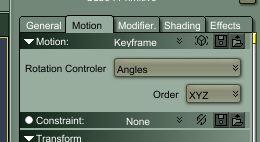Motion tab.
 DUDU
Posts: 1,945
DUDU
Posts: 1,945
Motion tab.
Which is the difference between “Quaternion” and “Angles” ?
What are “Moon light” and “Sun Light” ?
They are perhaps questions of beginner, but I never used these options (except “Quaternion, motion path, still and physics"”), and I do not find for what they are used…


Motion.JPG
260 x 142 - 16K


Comments
The different rotation method has to do with the order in which rotations are handled. I don't remember the specifics but if you rotate objects in a different order the object is turned differently (kind of like deciding if an algebra formula calculates the "multiplies" or "additions" first, you end up with a different answer).
There was also an issue with rotation keyframes understanding numbers like 720°.... I believe one of these settings will recalculate that number to be simply "0", while the other setting will understand you want it to fully rotate 3x.... When the feature was first introduced there was some ballyhoo about "Euler Angles" but I don't recall DAZ ever actually explaining it... Possibly a search in the forum archives would turn up an old post that explains it...
ADDED here is Mark Bremmer's explanation: http://forumarchive.daz3d.com/viewtopic.php?p=1597743
Sun and moon lights are Distant lamps that you add to your scene that are controlled by the Real Sky interface. When you position the sun/moon in Real Sky it controled those lamps in your scene.
Thanks Holly, and...
Welcome Home!
Good to see you!
I'm a little foggy today but yes there is a handy difference.
I use angles instead of a spin modifier often.
As holly said if you figure out how many rotations you want and use 360 degrees multiply by the time.
2 rotations in two seconds put a keyframe with 720 degrees at 2 seconds.
you can get an exact number of rotations in that time and stop in an exact position. Also it can be sped up and down with keyframe.
Quartermion messed me up it being expressed in 0 - 360 degrees I would always get a hickup in the animation at the crossing point.
But i'm sure it has a good use I just don't know what that is.
B
That seems easier to me to understand than the formulas…
I retain these explanations to look at more closely the next week end.
I will back to you if I block on something.
Thank you Holly and 8068!
With Quaternion, the rotation of the display gimbal is fixed, in that one axis always moves the others. You are also limited to +/- 180 degrees(360 total) on axis for animation. If you need to animate past 360 degrees of rotation, you will have to repeat a cycle of values or keyframes.
Euler angles(Angles) can rotate an axis independently depending on the XYZ orders with no limit of rotation values. However, I wouldn't rotate or input values greater than certain keyframe ranges if you want the rotation to animate correctly. If two axis end up on the same plane of rotation, also called gimbal lock, you can change the XYZ axis order to avoid it.
The above is just a basic observation related to Carrara. I don't know the math involved and I'm guessing quaternion is easier to figure out the math for most animations or mechanical parts.
After some tests, I believe to have understood the difference between Quaternion and Angles.
Previously, when I wanted that some things enters in rotation (I did not use the modifiers yet), I were to make a rotation of 180° to the maximum if not the object retrogressed until the next keyframe.
It is there that I see the advantage of the option “Angle” with in more one time-saver.
I believe that I will often use it.
Holly, I believe that you want to speak about the moonlight and sunlight lamp in “Insert” tab, those which intrigue to me are options located in “Motion” tab, it seems that one can apply them to any object but I do not see the effect that they bring…
Afflicted, I do not manage to make a screenshot…
Thank you.